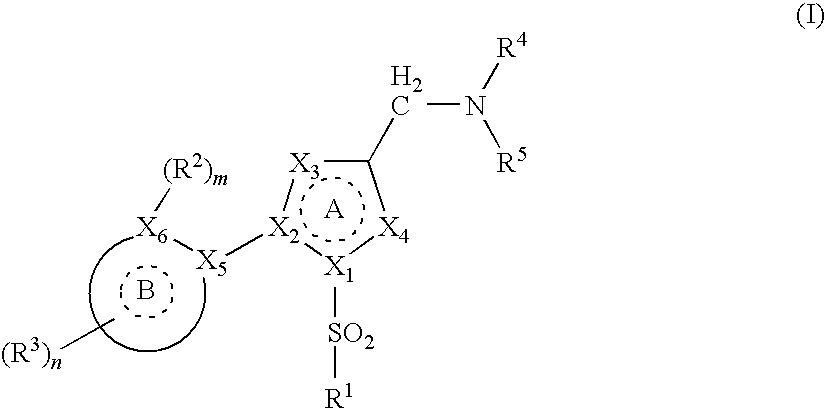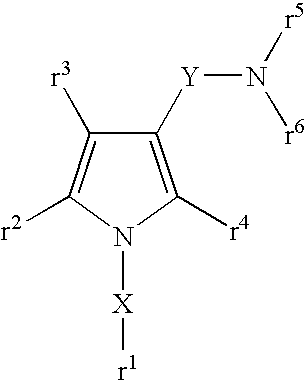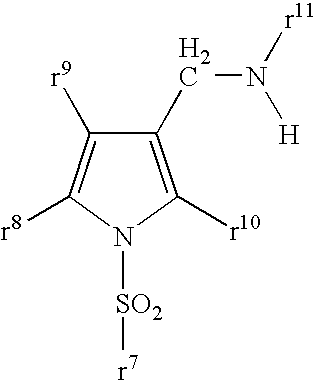5-Membered heterocyclic compound
a heterocyclic compound and 5-member technology, applied in the field of 5-membered heterocyclic compounds, can solve the problems that the proton pump inhibitor capable of sufficiently satisfying these requirements has not been found, and achieve the effects of superior proton pump inhibitory effect, inhibiting enzyme activity, and inhibiting the activity of the proton pump (h+/k+-atpase)
- Summary
- Abstract
- Description
- Claims
- Application Information
AI Technical Summary
Benefits of technology
Problems solved by technology
Method used
Image
Examples
reference example 1
4-bromo-5-(phenylthio)thiophene-2-carbaldehyde
[0291]To a solution of 4,5-dibromothiophene-2-carbaldehyde (1.0 g) in N,N-dimethylformamide (10 mL) were added potassium carbonate (665 mg) and thiophenol (448 mg) at room temperature. After stirring overnight at room temperature, water was added to the reaction mixture, and the mixture was extracted with ethyl acetate. The extract was washed with saturated brine, dried over anhydrous sodium sulfate, and concentrated under reduced pressure. The residue was purified by silica gel column chromatography (eluent: hexane-ethyl acetate=19:1→7:1) to give the title compound as a pale-yellow oil (1.1 g, yield 99%).
[0292]1H-NMR (CDCl3) δ: 7.39-7.43 (3H, m), 7.50-7.53 (2H, m), 7.60 (1H, s), 9.67 (1H, s).
reference example 2
4-bromo-5-[(3-methoxyphenyl)thio]thiophene-2-carbaldehyde
[0293]To a solution of 4,5-dibromothiophene-2-carbaldehyde (1.0 g) in N,N-dimethylformamide (10 mL) were added potassium carbonate (665 mg) and 3-methoxybenzenethiol (571 mg) at room temperature. After stirring overnight at room temperature, water was added to the reaction mixture, and the mixture was extracted with ethyl acetate. The extract was washed with saturated brine, dried over anhydrous sodium sulfate, and concentrated under reduced pressure. The residue was purified by silica gel column chromatography (eluent: hexane-ethyl acetate=19:1→7:1) to give the crude title compound as a pale-yellow oil (1.30 g, quantitative).
[0294]1H-NMR (CDCl3) δ: 3.81 (3H, s), 6.92-6.96 (1H, m), 7.06-7.10 (2H, m), 7.28-7.34 (1H, m), 7.61 (1H, s), 9.68 (1H, s).
reference example 3
4-bromo-5-[(3-fluorophenyl)thio]thiophene-2-carbaldehyde
[0295]To a solution of 4,5-dibromothiophene-2-carbaldehyde (1.0 g) in N,N-dimethylformamide (5 mL) were added potassium carbonate (665 mg) and 3-fluorobenzenethiol (522 mg) at room temperature. After stirring at room temperature for 6 hr, water was added to the reaction mixture, and the mixture was extracted with ethyl acetate. The extract was washed with saturated brine, dried over anhydrous sodium sulfate, and concentrated under reduced pressure. The residue was purified by silica gel column chromatography (eluent: hexane-ethyl acetate=19:1→9:1) to give the title compound as a pale-yellow oil (1.17 g, yield 99%).
[0296]1H-NMR (CDCl3) δ: 7.03-7.15 (2H, m), 7.20-7.25 (1H, m), 7.32-7.39 (1H, m), 7.65 (1H, s), 9.73 (1H, s).
PUM
| Property | Measurement | Unit |
|---|---|---|
| partial structure | aaaaa | aaaaa |
| acid secretion inhibitory effect | aaaaa | aaaaa |
Abstract
Description
Claims
Application Information
 Login to View More
Login to View More - R&D
- Intellectual Property
- Life Sciences
- Materials
- Tech Scout
- Unparalleled Data Quality
- Higher Quality Content
- 60% Fewer Hallucinations
Browse by: Latest US Patents, China's latest patents, Technical Efficacy Thesaurus, Application Domain, Technology Topic, Popular Technical Reports.
© 2025 PatSnap. All rights reserved.Legal|Privacy policy|Modern Slavery Act Transparency Statement|Sitemap|About US| Contact US: help@patsnap.com



